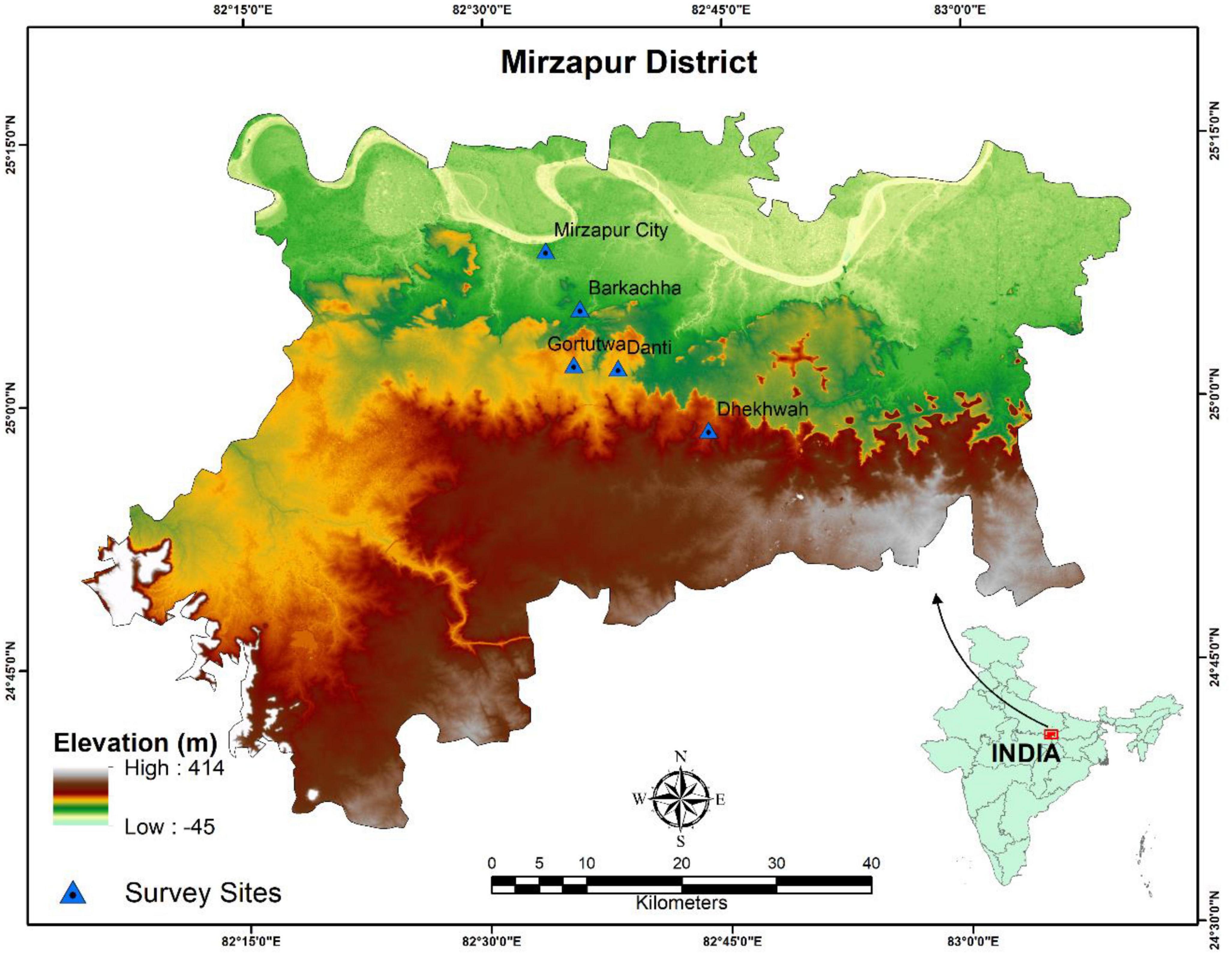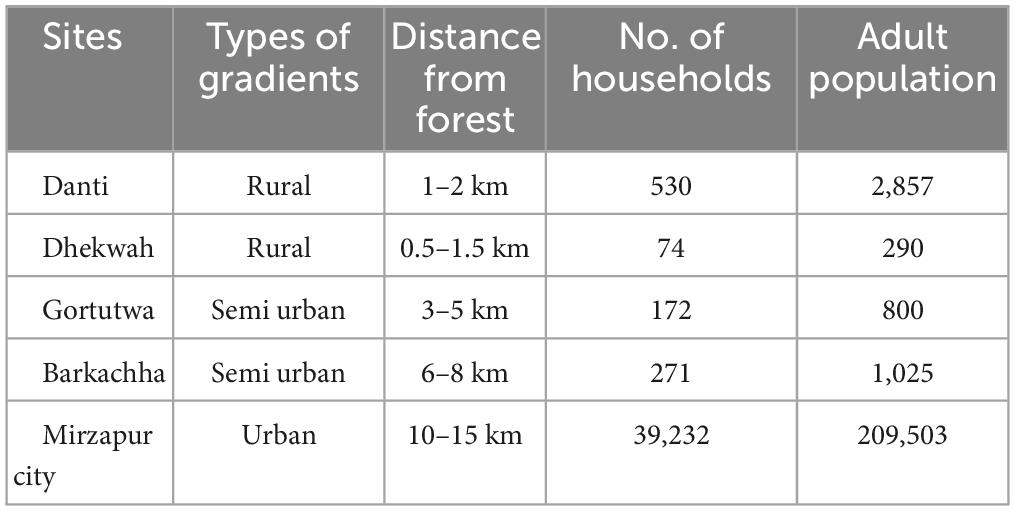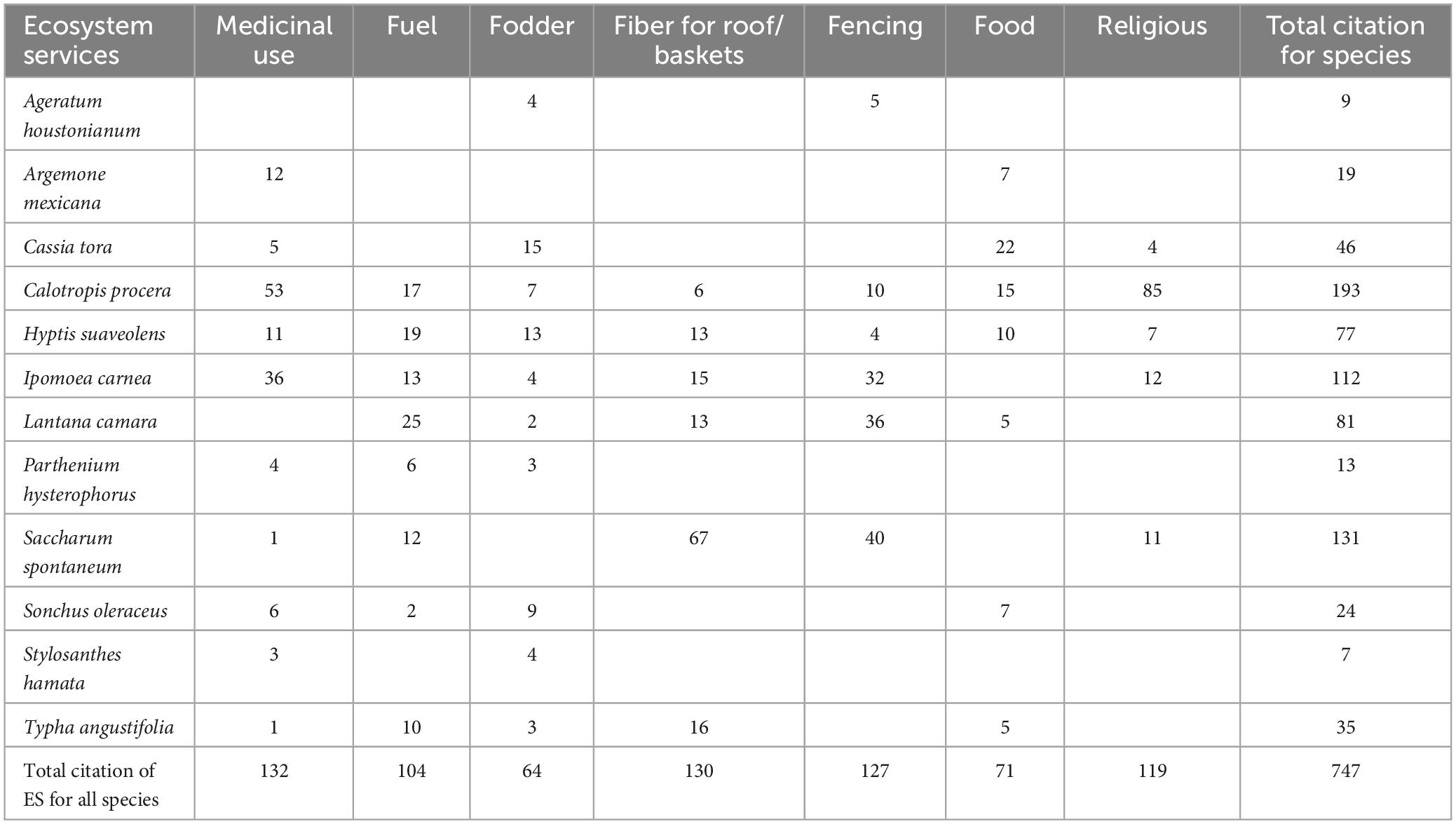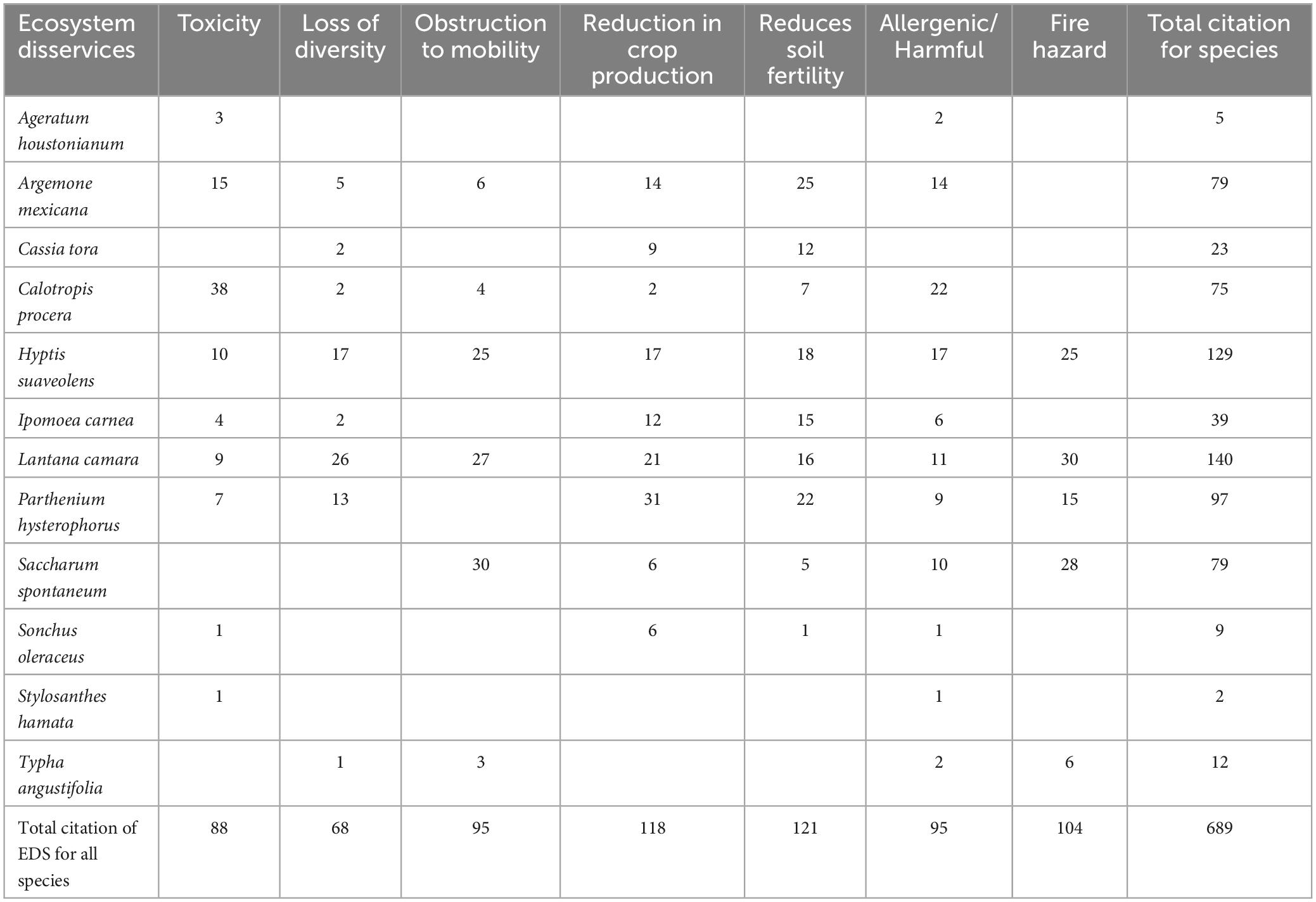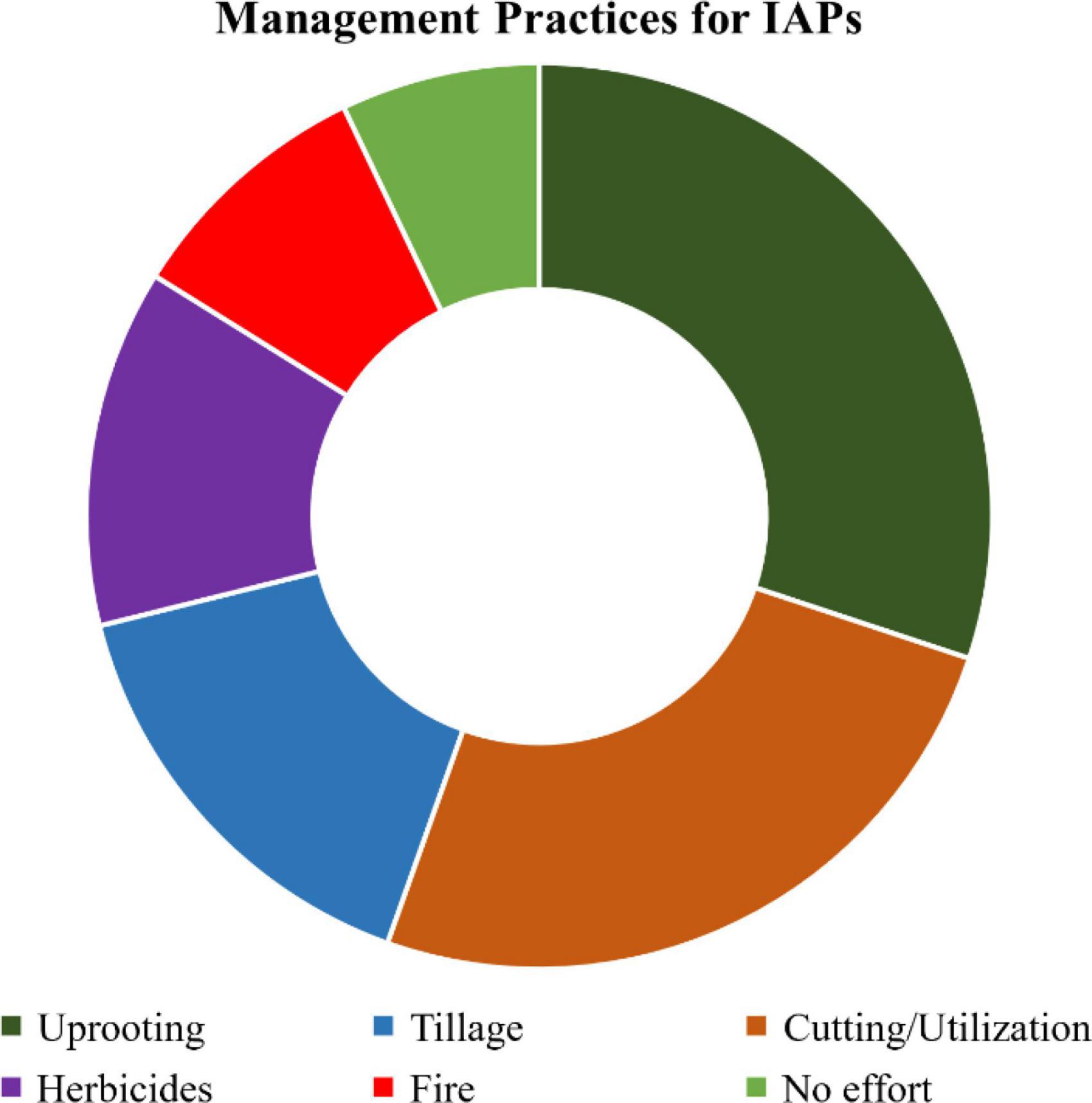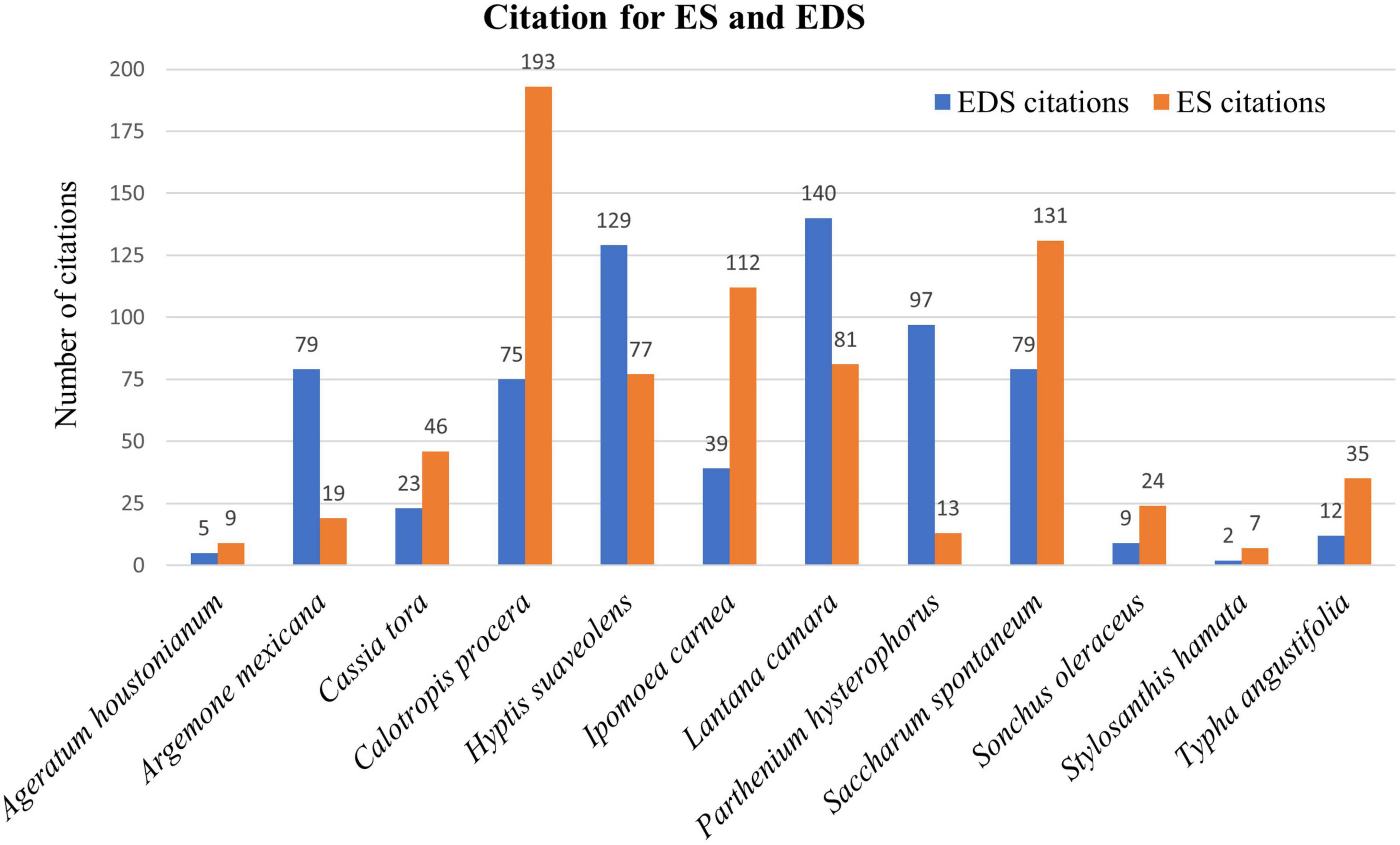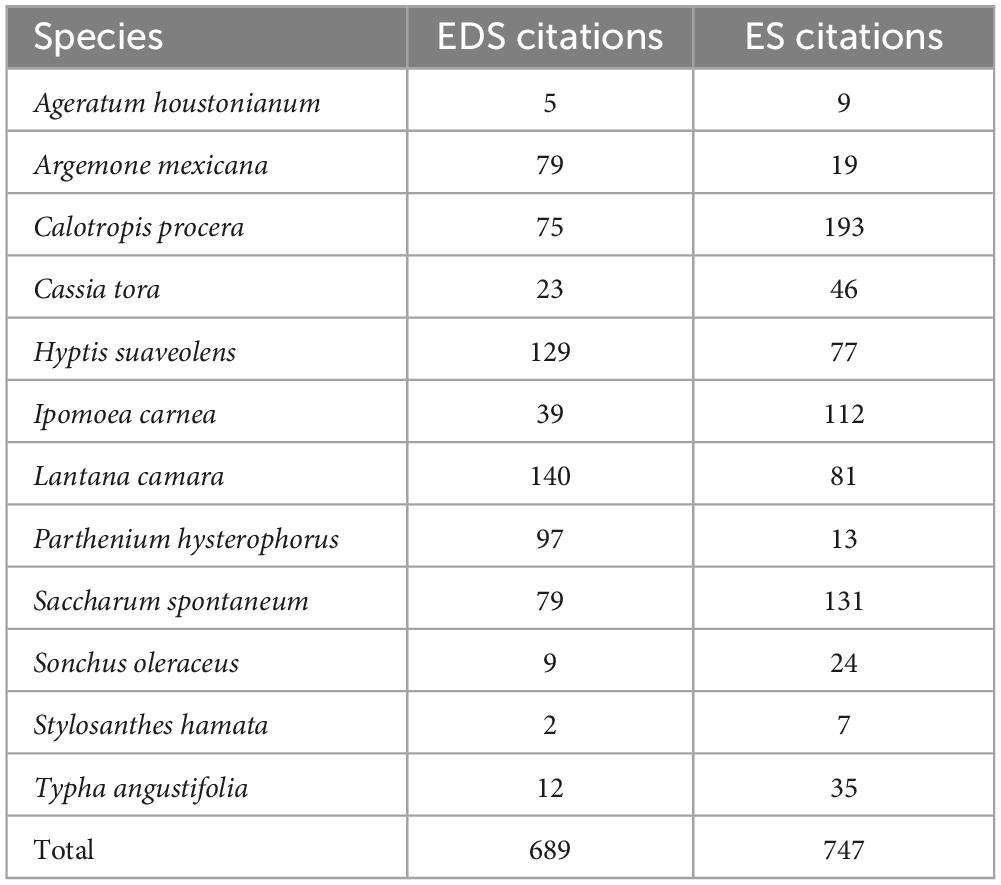- 1Institute of Environment and Sustainable Development, Banaras Hindu University, Varanasi, Uttar Pradesh, India
- 2ICAR-Central Agroforestry Research Institute, Jhansi, Uttar Pradesh, India
Invasive alien plants (IAPs) have become a serious threat to biodiversity, agriculture and socio-economic development. Several aspects, including the ecological and economic impacts of IAPs have been explored in the recent past, however, perceptions of ecosystem services (ES) and ecosystem disservices (EDS) have not been well studied. IAPs affect the lives of local people both positively (providing ES) and negatively (providing EDS). IAPs in this region have not been studied through the aspects of ES and EDS that integrate the views and perceptions of local communities. Keeping in view this research gap, the present study was conducted in the Mirzapur district (Uttar Pradesh, India) where IAPs are widely distributed. In five sites covering a rural to urban gradient with increasing distance from forest, we randomly selected 100 respondents–20 from each of the five sites for the survey. A semi-structured questionnaire was used to collect respondents’ perceptions on ES and EDS supplied by IAPs in their local habitats. The questionnaire was designed to obtain data on awareness and knowledge, perceptions of ES and EDS, attitudes toward management, and socio-demographic information. Results indicated that 95% of respondents were familiar with at least one of the 12 IAPs identified as being important in the region. Ipomea carnea and Stylosanthes hamata were the most and least frequently cited plants, respectively. Medical use and reduction in soil fertility were most perceived as ES and EDS, respectively. The value of Spearman’s rank correlation coefficient (Spearman’s ρ = 0.487, p > 0.05) indicates a non-significant correlation between ranks of ES and EDS cited by respondents. Older and less educated people were more aware of the impacts of IAPs. Uprooting was the most commonly used management practice to control the invasion of plant species. People’s attitudes toward the management of IAPs seem to indicate that they prefer to eradicate species that have direct harmful effects on human health and biodiversity. This study provides inputs for incorporating people’s perceptions into the control and management of IAPs in the forest region.
Introduction
Forests and agricultural landscapes are susceptible to invasion by alien plants. These invasions are either due to deliberate or accidental escapes of species from their sources or confinements (Saul et al., 2017). Some of the pathways for the introduction of invasive alien plants (IAPs) are transport stowaway, tourism, unscientific techniques, biological pest control, etc., (Richardson et al., 2003; Saul et al., 2017). Following the stages of introduction, establishment, and uncontrolled spread, most invasions become effective in the landscape (Sakai et al., 2001).
Invasive alien plants tolerate diverse environmental and biogeographic conditions and have adaptability to disturbance, which favors opportunities for their expansion (Burgiel and Muir, 2010) aided by climate change (Rai and Singh, 2020). Their high dispersal rate is attributed to the long fruiting and flowering periods that result in an extensive quantity of seeds produced (Ratnayake, 2014; Roberts et al., 2021). Self-replacing populations of IAPs established as a result of efficient reproductive strategies, rapid infestation and competitive growth adversely impact species richness in the forest fragments (Carey and Curtis, 1996; Rai and Singh, 2020). Several IAPs release allelochemicals, which suppress native species and facilitate IAPs colonization (Pinzone et al., 2018). Key industries like agriculture, forestry, fisheries, power generation, and global commerce are negatively impacted by IAPs (Lovell and Stone, 2005).
Invasive alien plants accelerate local extinction of native species (Islam et al., 2001), disturb trophic structure, create resource scarcity and alter ecosystem services and ecosystem health (Vivrette and Muller, 1977; Rai, 2015; Rai and Singh, 2020) and change ecosystem function (D’Antonio and Vitousek, 1992; Fensham et al., 1994). The impacts of IAPs on biodiversity include increased parasitism, predation, novel habitat formation, economic loss (Linders et al., 2019) and reduced agricultural productivity and forest diversity (Haines, 2016). The UN’s Global Assessment Report on Biodiversity and Ecosystem Services has identified IAPs as a key driver behind biodiversity loss (IPBES, 2019).
Human health is negatively impacted by the dispersion of vector-borne diseases, pollens, and toxins from IAPs (Plaza et al., 2018). Managing the effects of IAPs on ecosystems and the public’s wellbeing is among the top goals for the Cartagena Protocol on Biosafety and Convention on Biological Diversity (CBD) (Pyšek and Richardson, 2010).
The invasion and ecological repercussions of invasive species have been studied by various researchers worldwide (Moulton and Pimm, 1986; Sakai et al., 2001; van Wilgen et al., 2008; Willis et al., 2010; Vaz et al., 2017a) and on the Indian sub-continent (Sharma et al., 2009; Sharma and Raghubanshi, 2010, 2012; Rai and Singh, 2020), but the social aspects, such as people’s responses to biological invasions, have been largely overlooked (García-Llorente et al., 2008, 2011). IAPs provide both positive (ecosystem services, or ES) and negative (ecosystem disservices, or EDS), impacts (Potgieter et al., 2019), leading to disagreements about the use and management of IAPs (Vaz et al., 2017b; Novoa et al., 2018). Shackleton et al.’s (2019) perceptions of ES and EDS disrupt management initiatives, making it difficult to assess societal repercussions. People’s perceptions of the impacts of IAPs are influenced by different factors that vary along demographic gradients and regional biases over time. The perceptions vary with individual(s), species, effects (potential and realized), socio-cultural, landscape, and policy contexts. Some of the factors that inspire the development of perceptions are ecological conditions, social conditions, values and beliefs, impacts and benefits (Kapitza et al., 2019).
Integrating people’s perceptions of the impacts of IAPs on the ES and EDS provides understandings of local biological invasions (Potgieter et al., 2019; Shrestha et al., 2019) and management (Phillips et al., 2021; Wood and Den Breeÿen, 2021). This study was conducted to assess the perception for ES and EDS on local people affected by IAPs in rural, urban and semi-urban areas. The aims of the study were to (a) identify level of awareness for IAPs in the Vindhyan region (b) analyze people’s perceptions of ES and EDS of IAPs, (c) analyze how socio-demographic factors affect perceptions, (d) explore preferred management practices for IAPs.
Methodology
Study area
The study area lies in the Vindhyan biogeographic sub-zone in the district of Mirzapur in Uttar Pradesh, India (Figure 1). It has 16.94% of its total geographical area covered with forest (746.11 sq km) composed of very dense forest, moderately dense forest and open forest. It also consists of an additional area of 51.14 sq km covered with scrub forest (ISFR 2021). These forests also act as buffers for Chandraprabha Wildlife Sanctuary (CWLS) and Kaimoor Wildlife Sanctuary (KWLS) (Sinha et al., 2017; Goparaju et al., 2019). The vegetation type as per Champion and Seth (1968) classification is tropical dry deciduous forests (Goparaju et al., 2017), characterized by long, dry conditions, where vegetation is supported by monsoonal rainfall. This region is a human-dominated landscape where anthropogenic factors such as overexploitation of resources, habitat loss owing to habitat destruction, fragmentation, degradation and overgrazing pose a threat to the survival of species (Khan et al., 2019). Overall, the decrease in forest cover in the study area was recorded to be 57.62 sq km with respect to 2019 assessment (ISFR 2021). Terminalia arjuna (Roxb.), Tectona grandis L.f, Dalbergia sissoo (Roxb.), Butea monosperma (Lam.), Boswellia serrata (Roxb.), Anogeissus latifolia (Roxb. ex-DC.), Ziziphus mauritiana Lam., Ziziphus glaberrima L., Lagerstroemia parviflora (Roxb.), Acacia nilotica (Linn.), Acacia catechu L., Lannea coromandelica (Houtt.) Merr. etc., dominate the flora (Singh and Narain, 2009; Chaturvedi et al., 2011; Srivastava et al., 2020). The majority of the plant species are ethnobotanically significant.
We considered Mirzapur an important forest within the Vindhyan region due to the significant presence of forest cover, scrubs and anthropogenic pressure. Five sites located at varying distances from the nearest forests were selected randomly in the order of decreasing anthropogenic activities and disturbances, starting from the urban to rural gradient (Vakhlamova et al., 2014). The two rural sites were located within 0–2 km of the forest and the two semi-urban sites were located 3–8 km away (Table 1), and one urban site was located 12–15 km away from the forest. Both rural sites were surrounded by a mix of forest and agricultural fields, while both semi-urban sites are surrounded by agricultural fields. The urban site is surrounded by scarce agricultural fields, human settlements and micro- to macro-level manufacturing and processing units.
Data collection
A semi-structured questionnaire-based survey was conducted with inhabitants (≥18 years of age) at five locations (Potgieter et al., 2019; Singh et al., 2022) between January 2022 and June 2022. To avoid sampling bias and homogeneity, we used a snowball sampling technique, to conduct face-to-face interview and record twenty responses from various socio-demographic profiles, for a total of one hundred responses from five sites. The questionnaire (see Supplementary material; Roopa and Rani, 2012; Nemoto and Beglar, 2014) for the interview consisted of the following four sections: (1) environmental awareness and knowledge; (2) perceptions of ecosystem services (benefits) and disservices (negative effects); (3) attitude towards the management of selected IAPs; and (4) socio-demographic information of respondents. The 12 IAPs shortlisted for the questionnaire were screened from available literature (Raghubanshi et al., 2005; Reddy, 2008; Singh and Narain, 2009; Sandilyan et al., 2018; Khan et al., 2019; Sinha and Chaudhary, 2019; ISFR, 2021; ENVIS, 2022) considering their origin, invasiveness, impacts and pathways of invasion (see Supplementary material). Picture panels of Ageratum houstonianum Mill., Argemone mexicana L., Cassia tora L., Calotropis procera (Aiton), Hyptis suaveolens (L.) Poit, Ipomea carnea Jacq., Lantana camara L., Sonchus oleraceus L., Parthenium hysterophorus L., Saccharum spontaneum L., Stylosanthes hamata (L.) Taub., and Typha angustifolia L., were embedded in the questionnaire for the purpose of identification. The section on management of IAPs assessed the most preferred type of management approach for control of IAPs. Responses to section III were provided on a Likert scale of 1 (strongly disagree) to 5 (strongly agree). Written informed consent to participate in this study was provided by the participants.
Data analysis
The data obtained from the questionnaire were used to analyze the socio-demographic profile of the respondents, quantify respondents’ perceptions of ES and EDS and the management of IAPs. According to the Millennium Ecosystem Assessment (MA, 2005), ES are classified as regulating, provisioning, supporting, and cultural. EDS were categorized according to the outcomes perceived by respondents (namely- toxicity, loss of diversity, obstruction to mobility, reduction in crop production, reduced soil fertility, allergic or harmful effects and fire hazards). Spearman’s rank correlation coefficient (a non-parametric test that measures the relationship between two variables) (Mukaka, 2012) was used to analyze socio-demographic variables and ES and EDS citations. The prioritization of IAPs for the purpose of management was done on the basis of ranking of the ratio of perceived EDS and ES. Microsoft excel and IBM-SPSS software was used for statistical analysis. The reliability and internal consistency of the Likert-scale questions were assessed using Cronbach’s alpha in SPSS.
Results
Socio-demographic profile of respondents
A total of 100 responses were recorded from face-to-face interviews conducted. Respondents comprised 46% females and 54% males in the age range of 18 to 75 years (Table 2). Eighty-three percent of the total respondents were below the age of 50. Thirty-two percent of respondents were illiterate, and 84.38% of illiterate respondents were over the age of 31. Agriculture was observed to be the most common source of livelihood among the respondents, with 44% of citations. Sixty-seven percent of the respondents reported having a monthly income less than 5,000 Indian rupees (INR). Strong positive relationships between age and residence time (Spearman’s ρ = 0.698, p < 0.01) and occupation and income (Spearman’s ρ = 0.712, p < 0.01) of respondents were observed. Also, a moderately negative correlation (Spearman’s ρ = −0.558, p < 0.01) between age and education was observed.
Environmental awareness and knowledge
Respondents were aware of the IAPs present around them, their uses and impacts; however, 95% of respondents were not familiar with the term IAPs in any form or language. Respondents mentioned global warming (34%) and pollution (30%) as serious environmental problems for the planet. The most frequently identified IAPs through embedded pictures were Ipomea carnea (95%) and Calotropis procera (86%), while Stylosanthes hamata (3%) was the least identified IAP (Figure 2). Respondents also answered queries about the local name and the probable location where these identified species were located, how they managed them in their fields or surroundings and the ES or EDS they provided (see Supplementary material).
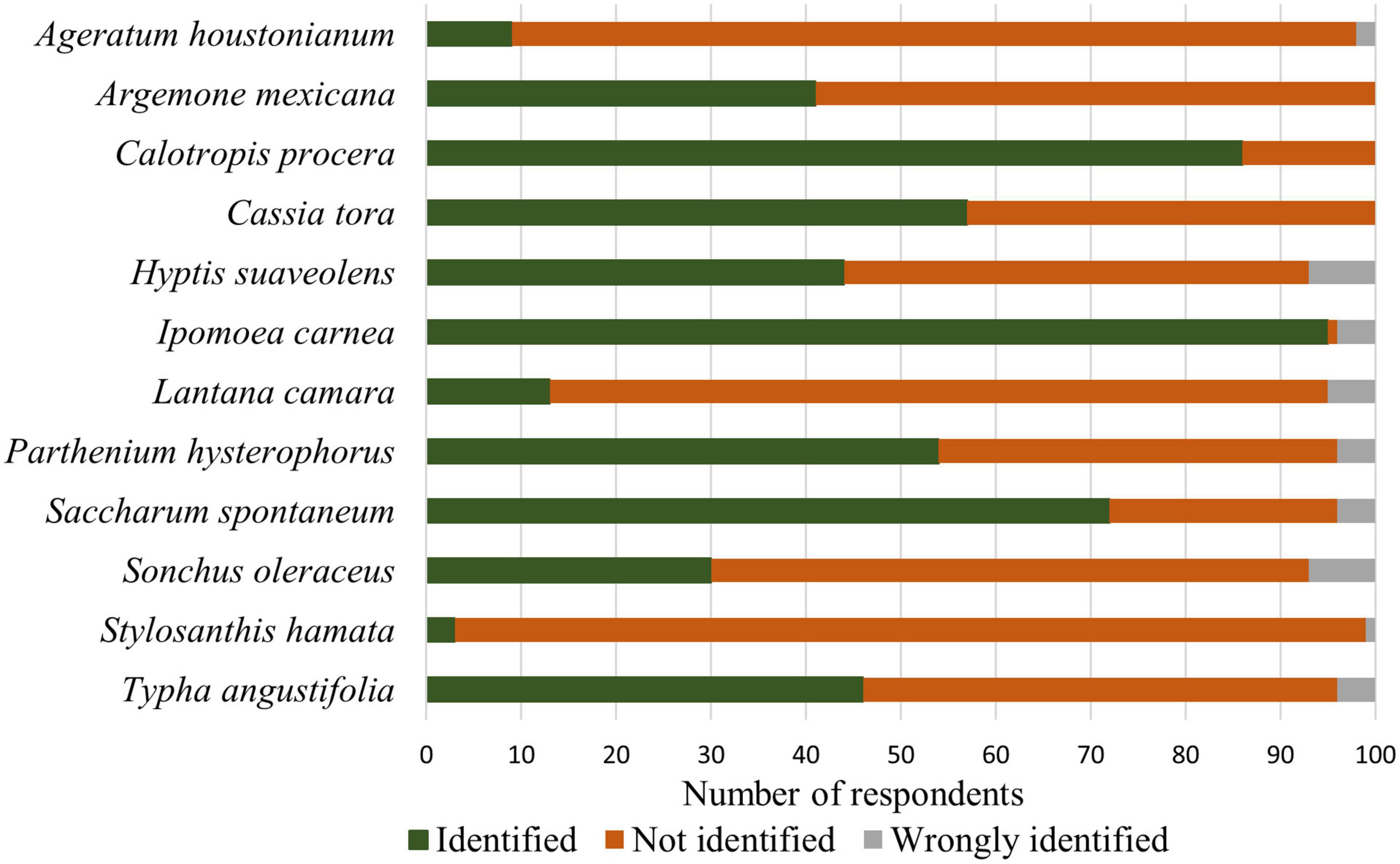
Figure 2. Results of identification of IAPs from embedded picture panels in the survey by respondents.
Ecosystem services and disservices
Analyses of responses found that respondents perceived IAPs positively as well as negatively, i.e., creating both ES and EDS. Respondents noted six ES (namely medicinal use for humans or domestic animals, fuel, fodder, fiber for roofs or baskets, fencing, food, and religious uses) (Table 3) and seven EDS (namely toxicity for grazing animals or humans, loss of diversity, obstruction to mobility through them, reduction in crop production, reduced soil fertility, allergic or harmful effects and fire hazard) (Table 4) for all twelve IAPs. Calotropis procera was the species most frequently perceived to provide ES (25.84 percent of total citations) due to its high religious value and medicinal use. People considered provisioning and cultural services to be the most significant ES for the 12 IAPs. Specifically, medicinal use (Calotropis procera) and fiber for roofs and baskets (Saccharum spontaneum) were the most cited ES.
The toxicity of Calotropis procera was the most perceived EDS individually, while reduced soil fertility was the most perceived EDS across all IAPs. Reduction in crop production and soil fertility were both cited for 9 out of 12 IAPs, mostly cited as a major issue by respondents involved in agricultural activities. Lantana camara (20.32%) and Hyptis suaveolens (18.72%) were as the species perceived to deliver most of the EDS. The value of Spearman’s rank correlation coefficient between the total number of ES and EDS for each IAPs is ρ = 0.487 (p > 0.05) which means that there is no significant correlation between ranks of ES and EDS cited by respondents.
Attitude towards the management of IAPs
Understanding the management approaches utilized for various IAPs can aid in decision-making (Weidlich et al., 2020; Singh et al., 2022). The management approaches mentioned by respondents were uprooting, cutting or biomass utilization, tillage, application of herbicides, fire and no effort to control, respectively, in the order of their citation (Figure 3). The mean Likert scale score on a scale of 1 (strongly disagree) to 5 (strongly agree) for respondents’ willingness to manage IAPs was 3.82, i.e., they are moderately agreeable to managing IAPs (mode = 4) (Table 5). Respondents in Gortutwa (semiurban) were neutral for management with a score of 3.1, while the other four sites were agreeable with scores ranging from 3.7 to 4.3. Respondents moderately agreed with the statement “control of IAPs is necessary to help conserve and protect the environment and biodiversity” with an overall mean Likert score of 3.71, whereas Mirzapur (3.3) and Gortutwa (3.15) were slightly neutral. The respondents moderately agreed to the statement “control of IAPs is necessary to protect the wellbeing of people” with a mean Likert score of 3.57. The respondents agreed to all three statements (mode = 4). Forty-eight percent of the total respondents agreed to contribute to the management of IAPs, either by creating awareness or by volunteering for future initiatives. However, 24 percent of the respondents were opposed to complete removal of one or more of the IAPs. The reliability and internal consistency of the Likert-scale questions were assessed using Cronbach’s alpha. As a result, the findings show that the Likert scale has strong internal consistency and reliability (Cronbach’s alpha coefficient = 0.858).
Species prioritization for management
Of the 12 selected species from Mirzapur region Parthenium hysterophorus, Argemone mexicana and Lantana camara were ranked first, second and third consecutively for the purpose of management, while Stylosanthes hamata and Typha angustifolia were the least prioritized by respondents. The rankings were based on the ratio of EDS and ES citations which was strongly related to EDS citation ranks (Spearman’s ρ = 0.781, p < 0.01). Across all species, the ranking order for management was Parthenium hysterophorus, Argemone mexicana, Lantana camara, Hyptis suaveolens, Saccharum spontaneum, Ageratum houstonianum Cassia tora, Calotropis procera, Sonchus oleraceus, Ipomea carnea, Typha angustifolia, and Stylosanthes hamata.
Discussion
Socio-demographic variables
A strong positive relationship between age and residence time of respondents (Spearman’s ρ = 0.698, p < 0.01) suggested that most residents had lived at the survey location since birth. A moderately negative correlation (Spearman’s ρ = −0.558, p < 0.01) between respondents’ age and their education indicates that the number of illiterate respondents increased with increasing age. Because the majority of respondents came from an agricultural background, there was a strong positive relationship between their occupation and income (Spearman’s ρ = 0.712, p = < 0.01).
Environmental awareness
The results showed that the respondents are aware of global warming and pollution, and other sources of environmental problems around them as a result of the active role of media (Thaker et al., 2017). However, although the majority of the respondents were not familiar with technical terms such as IAPs, they were largely aware of IAPs in their immediate surroundings and often identified these species. Their awareness was not limited to identification only and they were able to perceive how IAPs affect their surroundings i.e., create ES and EDS (Singh et al., 2022). Ipomoea carnea, Calotropis procera, and Saccharum spontaneum are readily observed in agricultural farms and surroundings so they were the mostly identified IAPs. However, Stylosanthes hamata is not as common as other IAPs in the region (Chandra et al., 2006) and was rarely identified.
Ecosystem services (ES)
The medicinal use, collection of fiber for roofs and baskets, use in fencing, as a source of fuel and religious use of IAPs were the most frequently cited ES. The socio-demographics of the surveyed sample suggests that low income of respondents is the main factor for utilization of these IAPs as medicine, fiber for roofs and baskets, fencing, fuel and fodder (Potgieter et al., 2019; Ntalo et al., 2022). Singh et al. (2022) have reported similar results in the riparian zone in Varanasi, India. The respondents considered IAPs to be equally contributing toward clean air, water or rainfall, wildlife habitat etc., and were not very specific while citing any regulating or supporting services. Thus, the analysis of results only yielded significant provisioning and cultural services of 12 IAPs as ES. The total number of ES citations for Calotropis procera, Ipomoea carnea, and Saccharum spontaneum were more than their EDS citations which suggests their naturalization and utilization by people in the region. Medicinal use and religious value of Calotropis procera has resulted in its high significance in terms of perceived ES.
Ecosystem disservices (EDS)
Reduction in crop production and soil fertility are two most perceived EDS created by IAPs. Both these EDS are strongly related as IAPs compete for light, nutrients, and water (Fried et al., 2017; Bajwa et al., 2019) to reduce soil fertility, ultimately resulting in a reduction in crop production (Cook et al., 2007). Fire hazards created during dry months are mostly multiplied with the presence of dried habits of IAPs (Keeley, 2000). Other negative impacts (EDS) perceived by respondents are human allergy (Potgieter et al., 2017), obstruction to mobility, toxicity and loss of diversity (Pyšek et al., 2020). Lantana camara and Hyptis suaveolens were perceived to create most of the EDS because of their presence in both agricultural and forest areas.
Management of IAPs
The selection of appropriate management and control methods for IAPs is solely dependent on the intentions and goals of management. IAPs in agricultural fields necessitate the use of management practices that do not destroy crops. Thus, uprooting, cutting or utilization, tillage, and the application of herbicide were the most preferred management practices. Based on the intensity and severity of the problem, respondents mostly chose uprooting (either manually or mechanically). On the other hand, respondents not associated with agriculture also preferred uprooting because of their experience with management of weeds in their home gardens or flower beds.
Because IAPs provide both ES and EDS (Figure 4 and Table 6), the key statements related to IAP management have a moderate level of agreement (Potgieter et al., 2019) on the Likert scale. IAPs providing both ES and EDS often result in disagreements about their management and use (Dickie et al., 2014; Vaz et al., 2017b). Such disagreements among stakeholders often interrupt management initiatives. Twenty-four percent of the respondents were opposed to the complete removal of one or more of the IAPs, while 48 percent of the total respondents agreed to contribute to the management of IAPs, either by raising awareness or by volunteering for future initiatives. According to García-Llorente et al. (2008), social views and stakeholder attitudes have a significant impact on management.
Prioritization of IAPs
Invasive alien plants are mostly managed with the motive to lessen the harmful impacts i.e., EDS. The species on top priority for management i.e., Parthenium hysterophorus and Argemone mexicana are mostly observed in agricultural fields and are directly faced by farmers and agricultural workers. Respondents reported them as harmful for their productivity and fertility of soil. Parthenium hysterophorus is reported to be the most notorious species that degrades crop productivity, and native biodiversity (Singh et al., 2022; Weyl, 2022). The least prioritized species was Stylosanthes hamata, besides being less familiar with this species, the pros and cons related to this species was also not much identified. Other IAPs in the priority list are also reported to create various negative impacts (EDS) and thus require attention toward management.
Limitations of the study
A main limitation of this study was that the data were collected from a confined sample from five sites and 100 respondents. Therefore, before implementing the results of the present study for management of IAPs in the study area, comprehensive research targeting particular demographics and a sample size relative to population size of the focus area is further required. Another limitation was that the data set was based on surveys and perceptions of local respondents, which are mainly influenced by how they perceived and understood the question, which may be influence responses (Mabuku et al., 2019). Although it is likely that perceptions of people would vary greatly across different geographical locations and socio-ecological settings, the approaches and methods used in the present research are broadly relevant to studies.
Conclusion
Invasive alien plants have been introduced into almost all ecosystems, either accidentally or purposefully. The current study highlights people’s perceptions of IAPs in terms of the ES and EDS they acquire and the management strategies they employ. People learn to make use of the species that are already available in their environment, as evidenced by the remarkably comparable perceptions of the ES and EDS (Spearman’s ρ = 0.487, p > 0.05) and their modest income from agriculture and daily earnings. Medicinal use, fiber for roofs or baskets, and fencing were the most common ES, while reduction in crop production and soil fertility were the most significant EDS recorded. People’s attitudes toward the management of IAPs seem to indicate that they prefer to manage species that have direct harmful effects on human health and biodiversity. The variation in people’s responses to key management statements demonstrates the importance of incorporating people’s perceptions and consultations through public forums to consider and address their concerns while developing initiatives and policies. Thus, the ES (or EDS) approach to conservation will inform allocation of resources and efforts toward both biodiversity protection and the long-term provisioning of ES to support human wellbeing.
Data availability statement
The original contributions presented in this study are included in the article/Supplementary material, further inquiries can be directed to the corresponding author.
Ethics statement
Ethical review and approval was not required for the study on human participants in accordance with the local legislation and institutional requirements. Written informed consent from the participants was not required to participate in this study in accordance with the national legislation and the institutional requirements.
Author contributions
SK and RM conceived the ideas and designed the study, with critical suggestions from RS and SP. SK and RM collected the data and led the writing of the manuscript. RM has done an initial literature survey. AT and SK processed and analyzed the data. AT guided the questionnaire preparation and also prepared the study area map using GIS software. RS and SP contributed critically to the manuscript’s draft and revision. GS provided the valuable support and input. All authors gave final approval for publication.
Acknowledgments
All authors are grateful to the faculty and officials of Institute of Environment and Sustainable Development, Banaras Hindu University for constant support. We acknowledge the contribution of various participants in our study who have provided their consent and valuable inputs. We also thank staff of Mirzapur forest division who coordinated and provided support for survey. SK thanks the University Grants Commission for providing Junior Research Fellowship.
Conflict of interest
The authors declare that the research was conducted in the absence of any commercial or financial relationships that could be construed as a potential conflict of interest.
Publisher’s note
All claims expressed in this article are solely those of the authors and do not necessarily represent those of their affiliated organizations, or those of the publisher, the editors and the reviewers. Any product that may be evaluated in this article, or claim that may be made by its manufacturer, is not guaranteed or endorsed by the publisher.
Supplementary material
The Supplementary Material for this article can be found online at: https://www.frontiersin.org/articles/10.3389/ffgc.2023.1194076/full#supplementary-material
References
Bajwa, A. A., Farooq, M., Nawaz, A., Yadav, L., Chauhan, B. S., and Adkins, S. (2019). Impact of invasive plant species on the livelihoods of farming households: Evidence from Parthenium hysterophorus invasion in rural Punjab, Pakistan. Biol. Invas. 21, 3285–3304. doi: 10.1007/s10530-019-02047-0
Burgiel, S. W., and Muir, A. A. (2010). Invasive species, climate change and ecosystem-based adaptation: Addressing multiple drivers of Global Change. Washington, DC: Global Invasive Species Programme (GISP).
Carey, A. B., and Curtis, R. O. (1996). Conservation of biodiversity: A useful paradigm for forest ecosystem management. Wildlife Soc. Bull. 24, 610–620.
Champion, H. G., and Seth, S. K. (1968). A revised survey of the forest types of India. Nasik: The Manager of Publications Delhi.
Chandra, A., Pathak, P. S., and Bhatt, R. K. (2006). Stylosanthes research in India: Prospects and challenges ahead. Curr. Sci. 90, 915–921.
Chaturvedi, R. K., Raghubanshi, A. S., and Singh, J. S. (2011). Carbon density and accumulation in woody species of tropical dry forest in India. For. Ecol. Manage. 262, 1576–1588. doi: 10.1016/j.foreco.2011.07.006
Cook, D. C., Thomas, M. B., Cunningham, S. A., Anderson, D. L., and De Barro, P. J. (2007). Predicting the economic impact of an invasive species on an ecosystem service. Ecol. Applic. 17, 1832–1840. doi: 10.1890/06-1632.1
D’Antonio, C. M., and Vitousek, P. M. (1992). Biological invasions by exotic grasses, the grass/fire cycle, and global change. Annu. Rev. Ecol. System. 23, 63–87. doi: 10.1146/annurev.es.23.110192.000431
Dickie, I. A., Bennett, B. M., Burrows, L. E., Nuñez, M. A., Peltzer, D. A., Porté, A., et al. (2014). Conflicting values: Ecosystem services and invasive tree management. Biol. Invas. 16, 705–719. doi: 10.1007/s10530-013-0609-6
Fensham, R. J., Fairfax, R. J., and Cannell, R. J. (1994). The invasion of Lantana camara L. in forty mile scrub National Park, North Queensland. Austr. J. Ecol. 19, 297–305. doi: 10.1111/j.1442-9993.1994.tb00493.x
Fried, G., Chauvel, B., Reynaud, P., and Sache, I. (2017). “Decreases in crop production by non-native weeds, pests, and pathogens,” in Impact of biological invasions on ecosystem services, eds M. Vilà and P. Hulme (Springer: Cham). doi: 10.1007/978-3-319-45121-3_6
García-Llorente, M., Martín-López, B., González, J. A., Alcorlo, P., and Montes, C. (2008). Social perceptions of the impacts and benefits of invasive alien species: Implications for management. Biol. Conserv. 141, 2969–2983. doi: 10.1016/j.biocon.2008.09.003
García-Llorente, M., Martín-López, B., and Montes, C. (2011). Exploring the motivations of protesters in contingent valuation: Insights for conservation policies. Environ. Sci. Policy 14, 76–88. doi: 10.1016/j.envsci.2010.11.004
Goparaju, L., Ahmad, F., and Sinha, D. (2017). Wildlife habitat suitability analysis around Madihan forest, Mirzapur district, Uttar Pradesh, India: A geospatial approach. Euras. J. For. Sci. 5, 13–28. doi: 10.31195/ejejfs.327362
Goparaju, L., Ahmad, F., and Sinha, D. (2019). Quantification and conservation status of forests fragments of tropical dry deciduous forests—a geospatial analysis running head: Tropical dry deciduous forests. Contemp. Probl. Ecol. 12, 629–641. doi: 10.1134/S1995425519060131
Haines, A. (2016). Addressing challenges to human health in the anthropocene epoch—an overview of the findings of the Rockefeller/Lancet Commission on Planetary Health. Public Health Rev. 37:14. doi: 10.1186/s40985-016-0029-0
IPBES (2019). “Summary for policymakers of the global assessment report on biodiversity and ecosystem services of the Intergovernmental Science-Policy Platform on Biodiversity and Ecosystem Services,” in IPBES secretariat, eds S. Díaz, J. Settele, E. S. Brondizio, H. T. Ngo, M. Guèze, J. Agard, et al. (Bonn: IPBES).
Islam, K. R., Ahmed, M. R., Bhuiyan, M. K., and Badruddin, A. (2001). Deforestation effects on vegetative regeneration and soil quality in tropical semievergreen degraded and protected forests of Bangladesh. Land Degrad. Dev. 12, 45–56. doi: 10.1002/ldr.418
Kapitza, K., Zimmermann, H., Martín-López, B., and von Wehrden, H. (2019). Research on the social perception of invasive species: A systematic literature review. NeoBiota 43, 47–68. doi: 10.3897/neobiota.43.31619
Keeley, J. E. (2000). “Fire and invasive species in Mediterranean-climate ecosystems of California,” in Proceedings of the invasive species workshop: The role of fire in the control and spread of invasive species, San Diego, CA.
Khan, K. A., Ankit, K., Kumar, H., De, R., Dar, S. A., Agrawal, M., et al. (2019). Population Status, Habitat and its Use by Blackbuck (Antilope cervicapra) in and around Kaimoor Wildlife Sanctuary, with reference to proposed Coal-based Thermal Power Plant of 1320 MW, Mirzapur, Uttar Pradesh. Technical Report. Dehradun: Wildlife Institute of India.
Linders, T. E. W., Schaffner, U., Eschen, R., Abebe, A., Choge, S. K., Nigatu, L., et al. (2019). Direct and indirect effects of invasive species: Biodiversity loss is a major mechanism by which an invasive tree affects ecosystem functioning. J. Ecol. 107, 2660–2672. doi: 10.1111/1365-2745.13268
Lovell, S. J., and Stone, S. F. (2005). The economic impacts of aquatic invasive species: A review of the literature. Working paper #05-02. Washington, DC: US Environmental Protection Agency.
MA (2005). Millennium Ecosystem Assessment. Ecosystems and human well-being, Opportunities and Challenges for Business and Industry. Washington, DC: World Resource Institute.
Mabuku, M. P., Senzanje, A., Mudhara, M., Jewitt, G. P. W., and Mulwafu, W. O. (2019). Strategies for coping and adapting to flooding and their determinants: A comparative study of cases from Namibia and Zambia. Phys. Chem. Earth 111, 20–34. doi: 10.1016/j.pce.2018.12.009
Moulton, M. P., and Pimm, S. L. (1986). “Species introductions to Hawaii,” in Ecology of Biological Invasions of North America and Hawaii. Ecological Studies, eds H. A. Mooney and J. A. Drake (New York, NY: Springer). doi: 10.1007/978-1-4612-4988-7_14
Mukaka, M. M. (2012). A guide to appropriate use of correlation coefficient in medical research. Malawi Med. J. 24, 69–71.
Nemoto, T., and Beglar, D. (2014). “Developing Likert-scale questionnaires,” in JALT 2013 conference proceedings, eds N. Sonda and A. Krause (Tokyo: Japan Association for Language Teaching).
Novoa, A., Shackleton, R., Canavan, S., Cybele, C., Davies, S. J., Dehnen-Schmutz, K., et al. (2018). A framework for engaging stakeholders on the management of alien species. J. Environ. Manage. 205, 286–297. doi: 10.1016/j.jenvman.2017.09.059
Ntalo, M., Ravhuhali, K. E., Moyo, B., Hawu, O., and Msiza, N. H. (2022). Lantana camara: Poisonous species and a potential browse species for goats in southern Africa—a review. Sustainability 14:751. doi: 10.3390/su14020751
Phillips, T. B., Bailey, R. L., Martin, V., Faulkner-Grant, H., and Bonter, D. N. (2021). The role of citizen science in management of invasive avian species: What people think, know, and do. J. Environ. Manage. 280:111709. doi: 10.1016/j.jenvman.2020.111709
Pinzone, P., Potts, D., Pettibone, G., and Warren, R. (2018). Do novel weapons that degrade mycorrhizal mutualisms promote species invasion? Plant Ecol. 219, 539–548. doi: 10.1007/s11258-018-0816-4
Plaza, P. I., Speziale, K. I., and Lambertucci, S. A. (2018). Rubbish dumps as invasive plant epicentres. Biol. Invas. 20, 2277–2283. doi: 10.1007/s10530-018-1708-1
Potgieter, L. J., Gaertner, M., Kueffer, C., Larson, B. M., Livingstone, S. W., O’Farrell, P. J., et al. (2017). Alien plants as mediators of ecosystem services and disservices in urban systems: A global review. Biol. Invas. 19, 3571–3588. doi: 10.1007/s10530-017-1589-8
Potgieter, L. J., Gaertner, M., O’Farrell, P. J., and Richardson, D. M. (2019). Perceptions of impact: Invasive alien plants in the urban environment. J. Environ. Manage. 229, 76–87. doi: 10.1016/j.jenvman.2018.05.080
Pyšek, P., Hulme, P. E., Simberloff, D., Bacher, S., Blackburn, T. M., Carlton, J. T., et al. (2020). Scientists’ warning on invasive alien species. Biol. Rev. 95, 1511–1534. doi: 10.1111/brv.12627
Pyšek, P., and Richardson, D. M. (2010). Invasive species, environmental change and management, and health. Annu. Rev. Environ. Resourc. 35, 25–55. doi: 10.1146/annurev-environ-033009-095548
Raghubanshi, A. S., Rai, L. C., Gaur, J. P., and Singh, J. S. (2005). Invasive alien species and biodiversity in India. Curr. Sci. 88, 539–540.
Rai, P. K. (2015). Paradigm of plant invasion: Multifaceted review on sustainable management. Environ. Monitor. Assess.. 187:759. doi: 10.1007/s10661-015-4934-3
Rai, P. K., and Singh, J. S. (2020). Invasive alien plant species: Their impact on environment, ecosystem services and human health. Ecol. Indic. 111:106020. doi: 10.1016/j.ecolind.2019.106020
Ratnayake, R. M. (2014). “Address on “Why plant species become invasive? – Characters related to successful biological invasion,” in Proceedings of the National Symposium on Invasive Alien Species (IAS 2014), Colombo.
Richardson, D. M., Cambray, J. A., Chapman, R. A., Dean, W. R. J., Griffiths, C. L., Le Maitre, D. C., et al. (2003). Vectors and pathways of biological invasions in South Africa: Past, present and future, Invasive species. Vectors Manage. Strateg. 12, 292–349.
Roberts, J., Florentine, S., van Etten, E., and Turville, C. (2021). Germination biology of four climatically varied populations of the invasive species African lovegrass (Eragrostis curvula). Weed Sci. 69, 210–218. doi: 10.1017/wsc.2020.99
Roopa, S., and Rani, M. S. (2012). Questionnaire designing for a survey. J. Indian Orthodontic Soc. 46, 273–277. doi: 10.1177/0974909820120509S
Sakai, A. K., Allendorf, F. W., Holt, J. S., Lodge, D. M., Molofsky, J., With, K. A., et al. (2001). The population biology of invasive species. Annu. Rev. Ecol. System. 32, 305–332. doi: 10.1146/annurev.ecolsys.32.081501.114037
Sandilyan, S., Meenakumari, B., Babu, C. R., and Mandal, R. (2018). Invasive Alien Species of India. Tucson: Centre for Biodiversity Policy and Law.
Saul, W. C., Roy, H. E., Booy, O., Carnevali, L., Chen, H. J., Genovesi, P., et al. (2017). Assessing patterns in introduction pathways of alien species by linking major invasion data bases. J. Appl. Ecol. 54, 657–669. doi: 10.1111/1365-2664.12819
Shackleton, R. T., Richardson, D. M., Shackleton, C. M., Bennett, B., Crowley, S. L., Dehnen-Schmutz, K., et al. (2019). Explaining people’s perceptions of invasive alien species: A conceptual framework. J. Environ. Manage. 229, 10–26. doi: 10.1016/j.jenvman.2018.04.045
Sharma, G. P., and Raghubanshi, A. S. (2010). How Lantana invades dry deciduous forest: A case study from Vindhyan highlands, India. Trop. Ecol. 51, 305–316.
Sharma, G. P., and Raghubanshi, A. S. (2012). “Invasive species: ecology and impact of Lantana camara invasions,” in Invasive alien plants: An ecological appraisal for the Indian subcontinent, eds J. R. Bhatt, J. S. Singh, S. P. Singh, R. S. Tripathi, and R. K. Kohli (Wallingford: CABI). doi: 10.1079/9781845939076.0019
Sharma, G. P., Raizada, P., and Raghubanshi, A. S. (2009). Hyptis suaveolens: An emerging invader of Vindhyan plateau, India. Weed Biol. Manage. 9, 185–191. doi: 10.1111/j.1445-6664.2009.00338.x
Shrestha, B. B., Shrestha, U. B., Sharma, K. P., Thapa-Parajuli, R. B., Devkota, A., and Siwakoti, M. (2019). Community perception and prioritization of invasive alien plants in Chitwan-Annapurna Landscape, Nepal. J. Environ. Manage. 229, 38–47. doi: 10.1016/j.jenvman.2018.06.034
Singh, R., Tiwari, A. K., and Singh, G. S. (2022). Perceptions of the impacts of invasive alien plants in the riparian zone of the Ganga River: Insights from Varanasi, India. River Res. Applic. 38, 1495–1509. doi: 10.1002/rra.4031
Singh, U., and Narain, S. (2009). Ethno-botanical Wealth of Mirzapur District, U.P. Ind. For. 135, 185–197.
Sinha, D., and Chaudhary, R. (2019). Wildlife inventory and proposal for sloth bear conservation reserve in Marihan-Sukrit-Chunar landscape of Mirzapur forest division, Uttar Pradesh. Mirzapur: Vindhyan Ecology and Natural History Foundation.
Sinha, D., Goparaju, L., Upadhyaya, S. K., Kumar, M., and Rexwal, O. (2017). Report on sloth bear habitats, assessment of human-bear conflict and identification of suitable corridors for wildlife conservation in District Mirzapur of Uttar Pradesh. Mirzapur: World Wide Fund for Nature.
Srivastava, R., Mohapatra, M., and Latare, A. (2020). Impact of land use changes on soil quality and species diversity in the Vindhyan dry tropical region of India. J. Trop. Ecol. 36, 72–79. doi: 10.1017/S0266467419000385
Thaker, J., Zhao, X., and Leiserowitz, A. (2017). Media use and public perceptions of global warming in India. Environ. Commun. 11, 353–369. doi: 10.1080/17524032.2016.1269824
Vakhlamova, T., Rusterholz, H. P., Kanibolotskaya, Y., and Baur, B. (2014). Changes in plant diversity along an urban–rural gradient in an expanding city in Kazakhstan, Western Siberia. Landsc. Urban Plann. 132, 111–120. doi: 10.1016/j.landurbplan.2014.08.014
van Wilgen, B. W., Reyers, B., Le Maitre, D. C., Richardson, D. M., and Schonegevel, L. (2008). A biome-scale assessment of the impact of invasive alien plants on ecosystem services in South Africa. J. Environ. Manage. 89, 336–349. doi: 10.1016/j.jenvman.2007.06.015
Vaz, A. S., Kueffer, C., Kull, C. A., Richardson, D. M., Schindler, S., Muñoz-Pajares, A. J., et al. (2017a). The progress of interdisciplinarity in invasion science. Ambio 46, 428–442. doi: 10.1007/s13280-017-0897-7
Vaz, A. S., Kueffer, C., Kull, C., Richardson, D. M., Vincente, J. R., Kühn, I., et al. (2017b). Integrating ecosystem services and disservices: Insights from plant invasions. Ecosyst. Serv. 23, 94–107. doi: 10.1016/j.ecoser.2016.11.017
Vivrette, N. J., and Muller, C. H. (1977). Mechanism of invasion and dominance of coastal grassland by Mesembryanthemum crystallinum. Ecol. Monogr. 47, 301–318. doi: 10.2307/1942519
Weidlich, E. W., Flórido, F. G., Sorrini, T. B., and Brancalion, P. H. (2020). Controlling invasive plant species in ecological restoration: A global review. J. Appli. Ecol. 57, 1806–1817. doi: 10.1111/1365-2664.13656
Weyl, P. (2022). Parthenium hysterophorus (parthenium weed), CABI Compendium. Wallingford: CABI International, doi: 10.1079/cabicompendium.45573
Willis, C. G., Ruhfel, B. R., Primack, R. B., Miller-Rushing, A. J., Losos, J. B., and Davis, C. C. (2010). Favorable climate change response explains non-native species’ success in Thoreau’s Woods. Public Lib. Sci. One 5:e8878. doi: 10.1371/journal.pone.0008878
Keywords: biodiversity, ecosystem services, ecosystem disservices, forest, invasive alien plants (IAPs), management, people’s perceptions
Citation: Kumar S, Meena R, Tiwari AK, Singh R, Patel SK and Singh GS (2023) Perceptions of impacts and management of invasive alien plants: a case study from Mirzapur, India. Front. For. Glob. Change 6:1194076. doi: 10.3389/ffgc.2023.1194076
Received: 26 March 2023; Accepted: 09 August 2023;
Published: 24 August 2023.
Edited by:
Jacqueline R. England, Commonwealth Scientific and Industrial Research Organisation (CSIRO), AustraliaReviewed by:
Rajendra Mohan Panda, University of South Florida, United StatesGopal Shukla, Uttar Banga Krishi Viswavidyalaya, India
Copyright © 2023 Kumar, Meena, Tiwari, Singh, Patel and Singh. This is an open-access article distributed under the terms of the Creative Commons Attribution License (CC BY). The use, distribution or reproduction in other forums is permitted, provided the original author(s) and the copyright owner(s) are credited and that the original publication in this journal is cited, in accordance with accepted academic practice. No use, distribution or reproduction is permitted which does not comply with these terms.
*Correspondence: Gopal Shankar Singh, Z29wYWxzaW5naC5iaHVAZ21haWwuY29t
†These authors have contributed equally to this work and share first authorship
 Sudhanshu Kumar
Sudhanshu Kumar Renu Meena
Renu Meena Amit Kumar Tiwari
Amit Kumar Tiwari Rinku Singh
Rinku Singh Sanoj Kumar Patel
Sanoj Kumar Patel Gopal Shankar Singh
Gopal Shankar Singh